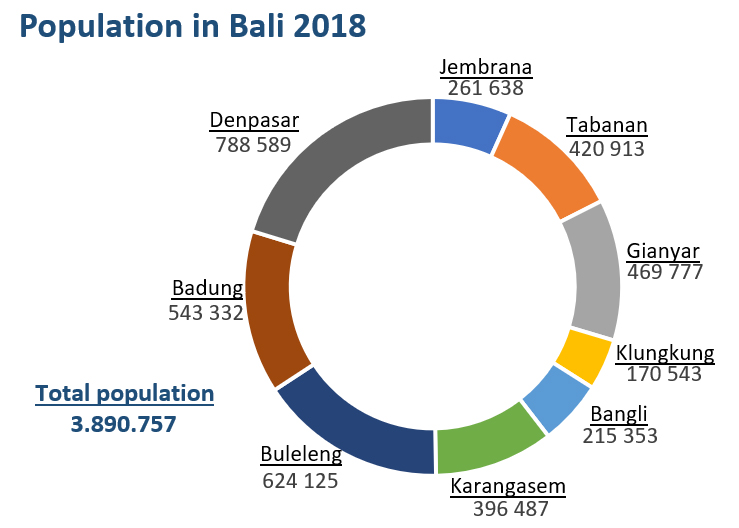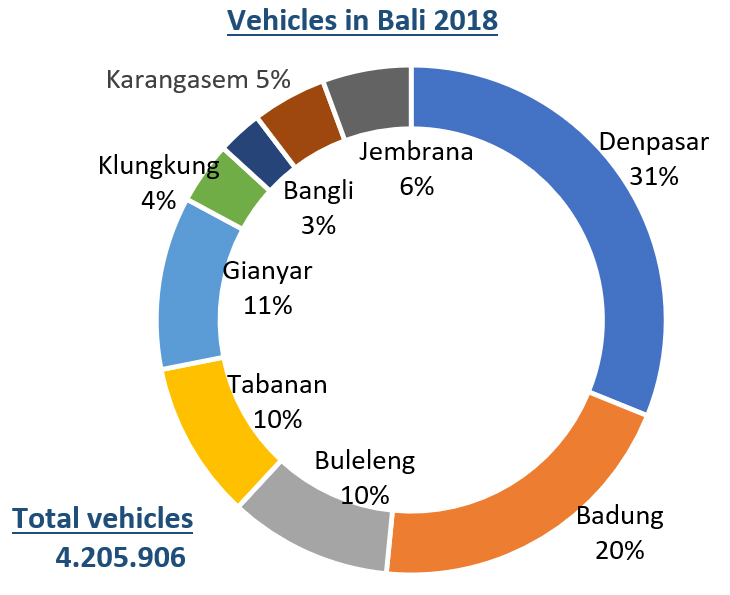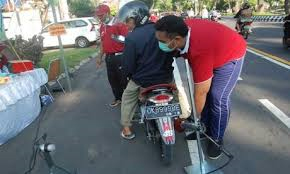Emissions from vehicles in urban areas of Bali
01/07/2020 Views : 394
Ainul Ghurri
Emissions from
vehicles in urban areas of Bali
In 2018,
the vehicle population in Bali reached 4,205,906 units; dominated by
motorcycles as much as 85.7% of the total. We can simply predict that
motorcycles contribute significantly to energy consumption and its exhaust
emissions in Bali. This is also one of the important concerns related to
traffic congestion and air quality, especially in urban traffic lanes.
In related
to tourism, South Bali, which consists of Badung and Denpasar, has been a major
tourism destination for quite a long time. One-third of Bali's population is
also concentrated in the area, as well as vehicle populations, including
motorbikes.
Figures 1, 2, and 3 showed the population of Bali by city / district, total number of vehicles and total number of motorbikes, respectively. These data indicated that the population of South Bali (Denpasar & Badung), amounting to 34% of the total population of Bali used 51% of the total vehicles circulating in Bali. Further, it was found that 49.9% of motorbikes in Bali were in Denpasar and Badung. This also indirectly illustrates the amount of energy consumption (liquid fuel, i.e. gasoline) would also be concentrated in the area; and so does the vehicle pollution generated by the vehicles. And as long as tourism develops in South Bali, vehicle growth will also occur constantly there.

Fig 1. Population in Bali 2018 (Source: BPS Bali)

Fig 2. Vehicles in Bali 2018 (Source: Direktorat Lalu Lintas Polda Bali)

Fig 3. Motorcycles in Bali 2018 (Source: Direktorat Lalu Lintas Polda
Bali)
Spot Emissiosn Check
Figures 1,
2, and 3 showed the population of Bali by city / district, total number of
vehicles and total number of motorbikes, respectively. These data indicated
that the population of South Bali (Denpasar & Badung), amounting to 34% of
the total population of Bali used 51% of the total vehicles circulating in
Bali. Further, it was found that 49.9% of motorbikes in Bali were in Denpasar
and Badung. This also indirectly illustrates the amount of energy consumption
(liquid fuel, i.e. gasoline) would also be concentrated in the area; and so
does the vehicle pollution generated by the vehicles. And as long as tourism
develops in South Bali, vehicle growth will also occur constantly there.
The
Denpasar Office of the Environment and Hygiene routinely conducts spot emission
checks every year in three busy traffic points in Denpasar, namely Renon,
Sesetan and Mahendradatta highways. Academics and students from Udayana
University were involved in this activity as observers as well as partners in
implementing the measurement of exhaust emissions. Emission measurements are
also supported by car and motorcycle dealers in Bali.
The exhaust emission checks include HC and CO. CO is carbon dioxide content, representing incomplete combustion in the engine combustion chamber of the vehicle. The greater the CO content, the greater the harmful pollutants in the flue gas, as well as the greater the amount of incomplete combustion of the fuel. While HC is unburnt hydro-carbon, part of the fuel that did not get burned. High CO and HC content indicates poor combustion conditions in the engine; can be caused by incorrect fuel selection or poor engine conditions. The threshold used as a reference is based on the Minister of Environment Decree No. 5 of 2006, as shown in Table 1.

Fig 4. Spot check emission (Source: www.denpasar.go.id)
Table 1. Emissions threshold according to Kepmen LH No. 5/2006

In the 2018 emission check spot, 1629 vehicles
were inspected; where there were 4.24% of vehicles with CO and / or HC
emissions exceeding the threshold. That amount could be considered as small,
but in terms of the amount or accumulation of emissions from all vehicles still
requires the attention from the public and the authorities. This is because
Bali as a world tourism destination requires an image as an environmentally
friendly tourism area. Emission check needs to be done routinely and followed
by air quality measurements at certain points that are considered critical as
pollutant accumulation
areas, so that air quality especially in urban areas could be assessed. The
implementation of emission checks can also be followed up into local
regulations in order to keep the environment clean and environment friendly. [Ainul Ghurri; Mechanical Eng. Department, University of Udayana; a_ghurri@unud.ac.id]
